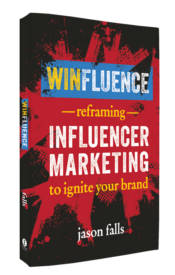What brands typically ask of influencers, and what influencers frequently ask of brands is broken. Influencer marketing agencies and software companies, especially those that are managed services, aren’t helping. And there’s an interesting contradiction to be found in the reason.
Ask any influencer or company invested in influencer marketing what the primary benefit of the practice is, and they immediately spout words like “genuine” and “transparent” and “human.” It is true. A person who has built an audience for themselves in the social media space, and who has a high degree of engagement and involvement with that audience is more of all of those things for a brand than traditional advertising mechanisms.
But when the two come to the table to figure out exactly what should happen to leverage those human qualities, they define output of a “campaign,” which is inevitably a set of “deliverables” for a set “cost.” See the mismatch?

The problem is the influencer marketing industry, for the most part, has fallen victim to the concept of being “data-driven.” That’s a fancy marketing technology term for “don’t let humans make the decision.” The brands obsess with impressions or reach, so the agencies, managed services and even influencers go find that cell on the spreadsheet and deliver on that number.
“Data Driven” is a fancy marketing technology term for “don’t let humans make the decision.”
– Jason Falls
Then some uninformed jackwagon asks what the ROI of the thing was and everyone gets confused and thinks the influencer was ineffective, rather than seeing they’re trying to use apples to measure oranges.
The obsession with reach, impressions, clicks, conversions or even the slightly better measures of those human traits—engagement—has turned influencer marketing into a pseudo-bot-driven economy. “I want X impressions and Y engagements for Z dollars. Go find the influencers that will deliver those numbers.” You don’t even have to be a human to make those decisions. Hence the rise of influencer marketing software.
Data Forces Us to Forget
The reliance on the MBA-ification of marketing is that it forces us to forget what we’re here to do: Communicate. The ultimate goal of any marketing effort should be to communicate something to an intended audience. Typically, that message is to try, buy or think differently about a brand, product, service or idea. Nike doesn’t sell tennis shoes or sportswear. They sell motivation. The success they’ve had in making people think differently about themselves fortunately leads to their desire to try or buy in order to live out that new expectation.
Ironically, the brand managers and ad agencies do still hold on to the concept of a creative brief, which is a guiding document for creating marketing campaigns or projects. A good creative brief typically includes the definition of the single-most important idea to communicate. Somewhere between the consumption of that directive and scoping influencer marketing engagements, we drop the ball and make decisions from the numbers in our spreadsheet.
I am currently frustrated by a specific influencer program I’m building for a client. My deliverables are not tied to a specific number of impressions, posts, engagements or conversions. I don’t want X Instagram Stories and Y YouTube videos plus Z Tweets. I want the influencers in question to help me communicate an idea consistently to their audience. The number of Instagram posts is irrelevant to me if they succeed in the goal.
Every influencer and talent manager to whom I’ve communicated this goal has responded the same way: “What specific deliverables are you looking for so I can build a budget?”
My answer, “How many does it take?”
They are obsessed with a cost-per-post economy. I am trying to communicate a message. One post won’t likely do it. The message needs to be reinforced. But every influencer and audience is different. So prescribing two posts per month for six months may catch the audience’s attention, imagination and deliver. Or that amount may get lost in their streams and prove ineffective. A series of 12 Instagram images with a clever caption might make the audience take note. But a single IGTV video with a heartfelt story from the influencer might do the trick by itself.
They are going to know the answer to my question better than I.
How many does it take?
The New Influencer Creative Brief
Brands often don’t know any better, so fixing the broken asks will take an effort from us all. Brand managers: Stop obsessing with a metric and start focusing on the real reason we do what we do: Communicate messages to an audience.
Influencers, talent managers, managed service providers, influencer marketing tools and services: Help yourselves by helping brands with a new creative brief of your own:
- Define the single-most important message to communicate
- Determine yourself how much and what kind of content will deliver that message meaningfully to your audience
- Scope that
Stop relying on the pay-per-post economy. It’s trite and transactional. It’s data-driven, not decision-driven. It thoroughly undermines the true value of what you do. It turns your talents in communicating into an assembly line of tasks. The really good ones among you figure out how to integrate the communication into that sausage factory, but in the end, the brand is typically holding a string of wieners that are just processed by-products of repetition.
Stop asking for or accepting a list of deliverables. There’s only one: Communicate the message.
Note: Photo by Patrick Fore on Unsplash

Order Winfluence now!
Winfluence – Reframing Influencer Marketing to Ignite Your Brand is available now in paperback, Kindle/eBook and audio book formats. Get it in the medium of your choice on Amazon or get a special discount on the paperback version of the book by clicking the button below, buying on the Entrepreneur Press bookstore and using the discount code FALLS20. That earns you 20% off the retail price. Read and learn why we’ve been backed into a corner to think influencer marketing means Instagram and YouTube and how reframing it to be “influence” marketing makes us smarter marketers.

